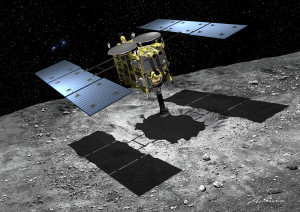Update: There is a launch postponement of Japan’s Hayabusa2 from the Tanegashima Space Center to December 3 (Wed.), 2014 (Japan Standard Time). The liftoff delay is the result of a go/no go assessment that carefully checked the weather forecast and found that strong wind exceeding the weather restrictions was projected around the launch pad at the scheduled launch time.

Japan’s Hayabusa2 will target “1999 JU3” – a C-type asteroid – for detailed study.
Artwork: Akihiro Ikeshita
Weather conditions have prompted the Japan Aerospace Exploration Agency (JAXA) to delay the launch of its asteroid explorer, Hayabusa2.
Liftoff of the probe is now slated to occur on December 3 onboard the H-IIA Launch Vehicle No. 26.
Hayabusa2 is a successor of “Hayabusa” (MUSES-C), which successfully returned to Earth bits of an asteroid in June 2010.
Hayabusa2 will target “1999 JU3” – a C-type asteroid – for detailed study.
The craft should arrive at the asteroid in mid 2018, loitering on site for one and half years before leaving the asteroid at the end of 2019 and returning its cache of samples to Earth around the end of 2020.
Artificial crater to be made
Among the spacecraft’s asteroid duties is to attempt a new function, making use of a “collision device.” This hardware will create a crater artificially a few meters in diameter on the space rock.
After making the crater, samples will be acquired for return to Earth. Those fresh samples would be less weathered by the space environment or heat.
Hopping MASCOT
Also onboard Hayabusa2 is the Mobile Asteroid Surface Scout, or MASCOT.
This asteroid lander was developed by the German Aerospace Center (Deutsches Zentrum für Luft- und Raumfahrt; DLR).
Once dispatched from the Japanese spacecraft, MASCOT will descend to the surface of the asteroid – which measures just less than a mile (one kilometer) across and whose gravitational acceleration is 60,000 times weaker than that here on Earth – from a height of approximately 330 feet (100 meters). Mascot will conduct its measurements over two full asteroid days and nights – a period lasting up to 16 Earth hours.

Mobile Asteroid Surface Scout, or MASCOT, is prepared by engineers at the
German Aerospace Center (Deutsches Zentrum für Luft- und Raumfahrt; DLR).
Credit: DLR
MASCOT weighs just 22 pounds (10 kilograms). It will use an eccentric arm installed in its interior to “hop” almost (230 feet (70 meters) across 1999 JU3 – delivering the first measurements from different locations on an asteroid’s surface.
Meanwhile, take a look at this special JAXA video on the upcoming mission:
https://www.youtube.com/watch?v=TDbtQd4LeuA&feature=youtu.be


